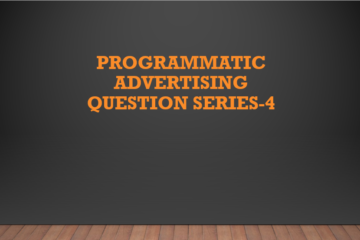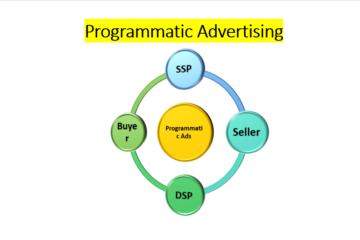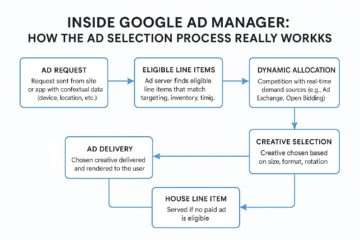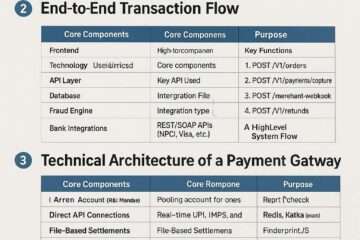

In this Part 2 we will discuss next set of 20 questions of DV 360 Interviews in Programmatic Advertising which will be helpful in cracking interviews for Programmatic Advertising:
Lets Start with some questions in Targeting and Audience Concepts in DV360
1. Explain contextual targeting and how it works in DV360.
Contextual targeting involves serving ads based on the content of the web page or environment in which the ad appears. In DV360, this means choosing specific keywords, topics, or categories related to the content a user is viewing. By leveraging machine learning and Google’s vast categorization of content, DV360 can serve your ads to relevant audiences based on the context of the page, like news, entertainment, sports, etc.
2. What is behavioral targeting and how does DV360 utilize it?
Behavioral targeting focuses on delivering ads based on user behavior, such as previous browsing activities, search history, and interactions. DV360 uses first-party data (from your website, apps, etc.), third-party data providers, and audience segments to target users who have shown interest in products or topics related to your campaigns.
3. What is retargeting and how do you set it up in DV360?
Retargeting, or remarketing, refers to targeting users who have already interacted with your brand or website. In DV360, this is set up by creating audience segments for users who have visited your site or taken specific actions (e.g., viewed a product but didn’t make a purchase). Then, you can set your line items to serve ads to these users as they browse other websites or apps.
4. Can you explain the concept of lookalike audiences in DV360?
Lookalike audiences are groups of users who share similar behaviors or characteristics with your existing high-value customers or audience segments. In DV360, you can create these audiences by leveraging Google’s machine learning, which analyzes your current audience and finds new users who exhibit similar behaviors, increasing the likelihood of engagement or conversion.
5. What are dynamic creative optimizations (DCO) in DV360?
Dynamic Creative Optimization (DCO) refers to the automated process of customizing creative ads based on user data in real-time. DV360 allows you to upload multiple ad elements (such as images, headlines, CTAs, etc.) and then dynamically assemble the most relevant ad variation based on the user’s data and the environment in which they are viewing the ad. This maximizes ad relevance and engagement.
Questions related to Campaign Setup and Execution
1. How do you create a campaign in DV360?
To create a campaign in DV360, you start by navigating to the “Campaigns” section and clicking “Create Campaign.” Then, you’ll define your campaign objectives, budget, and targeting criteria (such as audience, geo-location, devices, etc.). Afterward, you set up your line items and creatives, and launch the campaign.
2. What is the difference between a campaign and a line item in DV360?
A campaign in DV360 is a high-level structure that holds one or more line items. A line item is where you configure targeting, bidding strategies, budget, and creative assets for the ad delivery. Essentially, a campaign can contain multiple line items that may vary in targeting, bidding, and goals.
3. What are the different types of line items in DV360?
DV360 supports several types of line items, including:
- Standard: These are the most common line items and provide flexibility for most campaign types.
- Video: Used for video ads.
- Native: For native ad placements, which blend into the content of the site.
- Display: For static or rich media display ads.
- Audio: For audio ad placements.
- Sequential: For running a series of ads in a specific order to users.
4. How do you set up targeting at the line item level in DV360?
At the line item level, you can define targeting based on demographics, interests, location, device, audience segments, etc. You can also use contextual targeting options like keywords or topics. This helps tailor your line item to reach the desired audience with specific behaviors or characteristics.
5. How do you set up frequency capping in DV360?
Frequency capping can be set at both the campaign and line item levels. To set it up in DV360, go to your line item settings and locate the frequency capping section. You can limit the number of times an ad is shown to a user within a certain time frame (e.g., 3 impressions per day).
6. What is the importance of creative asset management in DV360?
Creative asset management is important because it allows you to organize, track, and optimize all your ad creatives within DV360. Proper management ensures that your creatives are correctly assigned to the appropriate campaigns and line items, and it helps streamline testing and optimization efforts to maximize performance.
7. What formats of ads are supported in DV360?
DV360 supports a variety of ad formats, including:
- Display ads (static and rich media)
- Video ads
- Native ads
- Audio ads
- Interactive ads
- HTML5 and other dynamic ad formats
- Over-the-top (OTT) ads
8. What is the purpose of the trafficking tab in DV360?
The trafficking tab in DV360 is where you upload and manage your creatives. It ensures the right ads are delivered with the correct targeting and in compliance with the campaign setup. It helps you track the status of each creative and its performance.
9. How do you implement a creative rotation strategy in DV360?
Creative rotation can be set up within a line item’s creative settings. You can either use automatic rotation, where DV360 will serve creatives evenly, or you can set specific weights to creatives (so some ads appear more frequently than others). This helps optimize performance by ensuring that the most effective ads are shown more often.
10. How do you implement dayparting in DV360?
Dayparting allows you to control when your ads are shown based on the time of day or day of the week. In DV360, you can set up dayparting under the line item settings, defining specific times and days for ad delivery. This ensures your ads reach users at the most optimal moments.
Questions related to Budget and Bidding
1. How does bidding work in DV360?
In DV360, bidding is the process of setting how much you’re willing to pay for each impression, click, or action. You choose a bidding strategy (e.g., CPM, CPC) and set a bid for your line items. DV360 then uses this information to decide how to allocate your budget and where to place your ads in auctions.
2. What are the different bidding strategies in DV360?
Some of the primary bidding strategies include:
- CPM (Cost Per Thousand Impressions): You pay per 1,000 impressions.
- CPC (Cost Per Click): You pay when a user clicks on your ad.
- CPA (Cost Per Acquisition): You pay when a user takes a specific action (e.g., conversion, sign-up).
- vCPM (Viewable CPM): Bids for ads that are viewable, based on Google’s definition of viewability.
- Target CPA: Optimizes bidding to get conversions at or below a specific cost per acquisition.
- Target ROAS (Return on Ad Spend): Optimizes bidding to maximize the revenue per dollar spent.
3. What is CPM, CPC, CPA, and CPL in the context of DV360?
- CPM (Cost Per Thousand Impressions): The cost per 1,000 times your ad is shown.
- CPC (Cost Per Click): The cost for each click on your ad.
- CPA (Cost Per Acquisition): The cost for each conversion or action taken by the user after interacting with your ad.
- CPL (Cost Per Lead): The cost for each lead generated, often used in lead-generation campaigns.
4. How do you set and manage budgets in DV360?
To set a budget in DV360, you define your budget at the campaign level. You can specify a daily or total budget, and DV360 will optimize ad delivery to stay within the specified limits. Additionally, you can adjust your budget over time based on performance and goals.
5. How do you optimize bidding strategies in DV360?
To optimize your bidding strategy in DV360, you need to track key performance indicators (KPIs) like conversion rate, ROAS, or engagement metrics. You can use automated bidding strategies like Target CPA or Target ROAS to allow DV360 to adjust bids in real-time. You may also A/B test different bidding strategies and adjust bids based on campaign performance.




























































